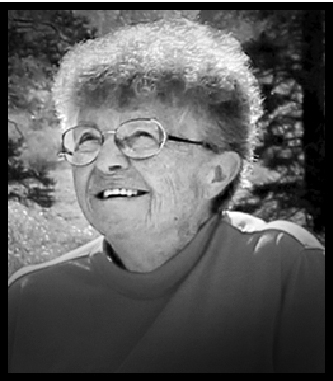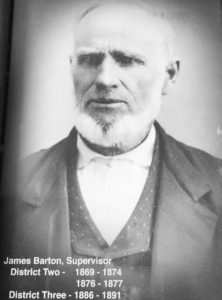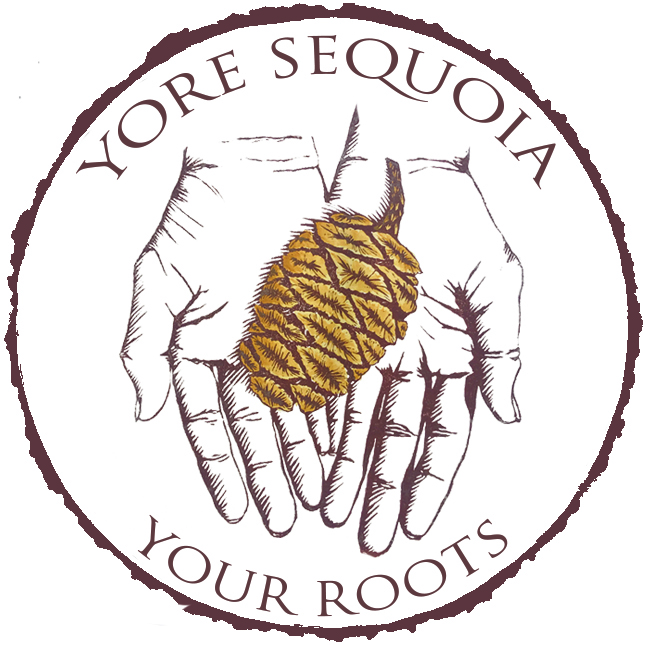
Settling in Three Rivers 140 years ago
There were houses built in Three Rivers, Calif., before it, but none have outlasted the ranch house on North Fork Drive that was built in 1880. And, in that time, the oldest home in Three Rivers, located at the confluence of the Kaweah River’s Middle and North forks, has been owned by just two families — the Bartons, then the Pierces.
Part One: The Builders
This segment was written by Sarah Elliott, whose paternal great-great-grandfather built the house.
On April 30, 1865, the Barton family left Davenport, Iowa, and began their 2,000-mile journey by covered wagon across the plains.
James and Susan Barton and their nine children — ranging in age from 22 years to nine months — arrived September 6 in the California mining town of Columbia, where they met up with James’s younger brother, Stephen, who had come West in 1854.
The Bartons stayed in the Mother Lode mining region for just a month before heading south to Visalia. In his possession, James had a land grant for 120 acres that had been given to his father in partial payment for his service in the War of 1812.
Upon location of the parcel, situated west of Elderwood, son Hudson later said: “A poorer piece of ground we couldn’t have found.”
The family then homesteaded in the Auckland area, in the foothills north of present-day Elderwood. It was here where their 11th child, Milton Montgomery “Mont” Barton, was born on Feb. 14, 1867.
James and Susan later moved to Three Rivers after their son, Orlando (1847-1917), had acquired some property on the North Fork in 1878. They lived in a log cabin along the North Fork river near present-day Kaweah River Drive until they completed their ranch house in 1880.

James was a member of the Tulare County Board of Supervisors for 17 years. He would walk to and from Three Rivers to attend the meetings in Visalia, a distance of 35 miles one way.
In 1888, Mont married Harriet “Hattie” DeMasters. The Barton house and 120 acres were subsequently deeded to Mont.
On Sept. 16, 1910, Mont was tragically killed while installing the first electric irrigation pumps in the area for the Elderwood Citrus Development Company, owned in part by his brother, Jason. The commercial use of electricity was largely untried and Mont’s electrocution was caused by a lethal combination of water, electrical lines, and a misinterpreted signal that caused a switch to be thrown too soon. He was the first person to be buried in the newly established Three Rivers Cemetery.
Susan Barton died Jan. 19, 1912, on the couple’s 69th wedding anniversary, at the age of 88. Less than eight months later, on Sept. 1, 1912, James died at the age of 93 at his beloved Three Rivers ranch. Both are buried in the Three Rivers Cemetery. Hattie and her youngest of four children, daughter Lois, left the Three Rivers ranch and resided in Elderwood. In 1920, when Lois was 12, they moved to San Jose where Hattie felt she could ensure a better education for her daughter.
Lois was the first in the family to graduate college, earning a master’s degree in chemistry from Stanford University.
James and Susan Barton are my great-great-grandparents. They are the first of what has now been six generations of Bartons to reside in Three Rivers, all on land originally owned by them or their children.
* * *
The next owners of this historic ranch house were James and Julia Pierce, beginning in 1911. Today, the property continues to be owned by Pierce descendants.
Part Two: The New Owners
This segment was written by Juanita Tolle (1931-2017), who lived on the ranch with her mother and grandparents from the age of three months until she was 12.
My grandfather, James H. Pierce, was an oil company superintendent in Coalinga. In 1910, he and his wife, Julia, made a vacation trip to Giant Forest.
They traveled to Lemon Cove by train then made the trip up the North Fork road by horse-drawn stage. The stage stopped at the Mont Barton ranch for lunch. The North Fork road passed directly in front of the ranch house.

(The front of the ranch house faces the river and the North Fork road used to pass within 30 feet of the front door. In 1892, the roadway was moved down slope from the house and closer to the river. As buggies gave way to cars, and cars began to travel faster, this curvy section of road — known as Pierce’s Corner — became notorious for traffic accidents. The road was rerouted in the 1980s and today crosses the ranch behind the house.)
James and Julia fell in love with the ranch and the area. Due to the untimely death of Mont Barton, the Barton family was in the mood to sell, so a deal was made. A deed was recorded June 13, 1911, which transferred the property from Milton M. Barton, et al., to James Henry Pierce.
In the years prior to the formation of the National Park Service in 1916, the U.S. Cavalry came each summer to supervise Sequoia National Park. The troops rode up the North Fork road right in front of the ranch house.
The Hengst family’s cattle were also driven past the ranch house each year on their way to summer forage in the high country. Imagine the dust, bellowing cattle, and shouting cowboys.
Redwood logs that had washed downriver in the flood of 1867 provided ample wood for picket fences that demarcated much of the ranch property. Some sections of this fence remain today.
My grandparents used kerosene lamps to light the house. They cooked on a woodstove — inside in the winter and outside under the grape arbor in the summer. Many a delicious meal was created and served from this woodstove, which is still in the house today along with a supplementary electric stove. The other heat source in the house was the fireplace in the living room. The fireplace had a granite slab as a hearth, a brick-and-mortar chimney, and cast-iron owl andirons to hold the logs.
At bedtime, the family carried hot flatirons or heated rocks wrapped in newspaper to warm their beds in the cold bedrooms. The remainder of the nightly fire was covered with ashes to provide hot coals to start the next morning’s fire.
The foundation of the house includes large flat granite rocks plus occasional sturdy redwood posts to share the burden of weight. A second story was added to the house for more bedroom space, but studs for support were not included.
The upper rooms and porch shake a bit, which adds to the charm of the house.
The kitchen floor creaks and slants, but holds an oak table that can be extended to seat 20 people. Over the years, other floors and doors have sagged and have been shored up by helpful neighbors.
The original paint on the house was maroon with green trim, but little evidence of this remains today. The screened-porch doors were added in 1915 and have been patched with various bits of board over the years.
The plan for domestic water was well thought out. A good spring a half mile up the North Fork road was boxed with redwood and a small iron pipe was laid in the Brundage ditch to keep the spring water cool in the summer and safe from freezing in the winter.
There was another spring below the house enclosed by granite boulders that later became a water supply for the house. The Pierces named their property Rock Spring Ranch.
Mont Barton had built a flume to the washing area to run a waterwheel that operated a washing machine.
We had a three-hole outhouse outside the fence beyond the big walnut tree, complete with spiders and the Montgomery Ward catalog.
The ranch house had an inside bathroom with a claw-foot bathtub. We had no hot water heater so water was heated on the stove.
A large copper kettle made in Pennsylvania was left behind by the Barton family. Grandmother Pierce used it to scald butchered hogs, made soap in it during World War I, and boiled clothes in it. The kettle was later professionally polished and has been a treasure in our family.
We had a telephone on the back porch. To make a call, we cranked the phone to reach the local operator, who was Rena (Alles) Ogilvie during my childhood. Rena would either connect the caller with the person they were calling or, in many cases, could tell you where they were: “She’s up visiting the Petersons” or “They went to town this morning,” etc.
With the ranch, the Pierces inherited fruit orchards that included several acres of apple varieties, citrus, olives, peaches, plums, apricots, pears, nectarines, quince, persimmons, and pomegranates. In the fall, Jim and Julia stayed busy selling apples and cider along with the Savages, Taylors, and Mehrtens.
A large walnut tree outside the kitchen and an almond tree provided annual crops of tasty nuts. As the apple orchards diminished, the orange and grapefruit harvest became the main income.
Jim and Julia Pierce developed a beautiful flower garden of roses, irises, Matilija poppies, zinnias, jasmine, and many other favorites. At one time, Julia had 75 different varieties of iris in her garden. When the irises were in bloom, her garden would be advertised in the Visalia newspaper as a place to visit.
An earth cellar was built under the ranch house. In the winter, melons, cabbages, apples, and squash were stored there. Grandmother Pierce canned dozens of jars of canned fruit during the summer that were stored on the cellar shelves and provided tasty desserts during the winter.
The family had a Jersey cow named “Old Pet,” who produced pans of whole milk that were cooled in the cellar. This milk provided rich cream for churning butter, milk to drink, and to make ice cream in the summer.
To make the ice cream, the family drove their wagon six miles to the Hammond powerhouse to secure 100 pounds of block ice. The ice was wrapped in newspaper and made a cool seat on the ride home.
Part Three: The Pierce family
This segment was written by Juanita Tolle.
My uncle, Bruce, and aunt Mary were born in Three Rivers, joining their two sisters, Frances and Elizabeth (my mother).
Grandmother Pierce was a teacher (graduate of Wilson College in Pennsylvania) and home-schooled her children during the early elementary grades. Then they all went to Sulphur Springs School (today, the private residence with a bell tower on the south end of Kaweah River Drive) and Woodlake High School. My mother attended UCLA for two years.
I lived on the ranch from the age of three months to 12 years (1932 to 1945) with Mother and Grandmother Julia. Uncle Bruce was there until he left to attend Stanford University to obtain a degree in Mining Engineering and, later, he served in the U.S. Army in World War II.
Aunt Mary was with us until she entered training at the Stanford School of Nursing and later served as an Army nurse in World War II.
Frances had married in 1931 and was living in Washington with her husband.
My mother worked in Visalia and Grandmother Julia (“Nana”) was my primary caretaker. She was an intelligent, dignified, courageous lady with a wonderful sense of humor.
Grandfather Pierce left the ranch in the late 1930s because severe allergies and asthma were severely affecting his health. He lived in Hermosa Beach and later in Banning, where he found the desert climate the most compatible for his health.
In the late 1930s, the back porch was enlarged and screened in to accommodate a wringer washing machine and a flush toilet, and still serves these purposes today. At the time, this was a big step forward in family convenience.
At age 60, Grandmother obtained her California teaching certificate and taught at the CCC camps in Three Rivers for several years. She found this role very rewarding as many of the young men could not read or write and were very grateful to her for teaching them these skills. Her last teaching assignment was in a two-room country school south of Tipton (Hanby School).
Grandmother Julia was creative in arranging transportation for herself between her job assignments and the ranch as she never learned to drive a car. She continued to manage the ranch affairs with help from Bruce, my mother, and local handymen, living there until her death in May 1948.
My mother remarried in December 1944 and we moved to Morro Bay in 1945. After Grandmother Julia died, mother looked for someone to rent the ranch house and oversee the property.
Dale and Virginia Williams rented the house for 18 years (Virginia was a former publisher of the Three Rivers Current newspaper in the 1950s). After they built their own home on Kaweah River Drive, Joe Doctor (the late Tulare County historian and author) and his family rented the house for several years.
Eventually, Joe’s daughter, Julie Doctor, became the primary renter for several more years. When Julie built her own house just upriver and moved into it, she was successful in finding a willing caretaker to live in and care for the ranch house.
Billy Hancock is the current caretaker and has proved to be a very satisfactory, caring occupant. Julie still oversees the property and pastures her horses there.
After Grandmother’s death, the ranch was divided amongst the four children. Frances and Mary gave up their shares to Bruce’s wife, Helen, and her sister, Charlotte.
Mother and I shared a quarter interest, even though Mother did the lion’s share of the business affairs. After Bruce’s death, Helen and Charlotte wanted to sell the ranch property, and all but 8.04 acres was sold in the early 1980s.
Helen retained her share for her two children. I later bought out Charlotte, so the current ownership is Helen Pierce, 50 percent, and me, 50 percent.
The property sale was a very painful process for me because I love this ranch so much. My fond memories are too numerous to include here.
The river is still one of my favorite spots. Many summer hours were spent in the river, diving for rocks and enjoying the cool relief from the summer heat. Mother and I shared a bedroom and the sound of the river lulled us to sleep each night.
Unfortunately, more recent floods have drastically changed the configuration of the “swimming pool” in front of the ranch house, and the main river has intruded into the North Fork.
